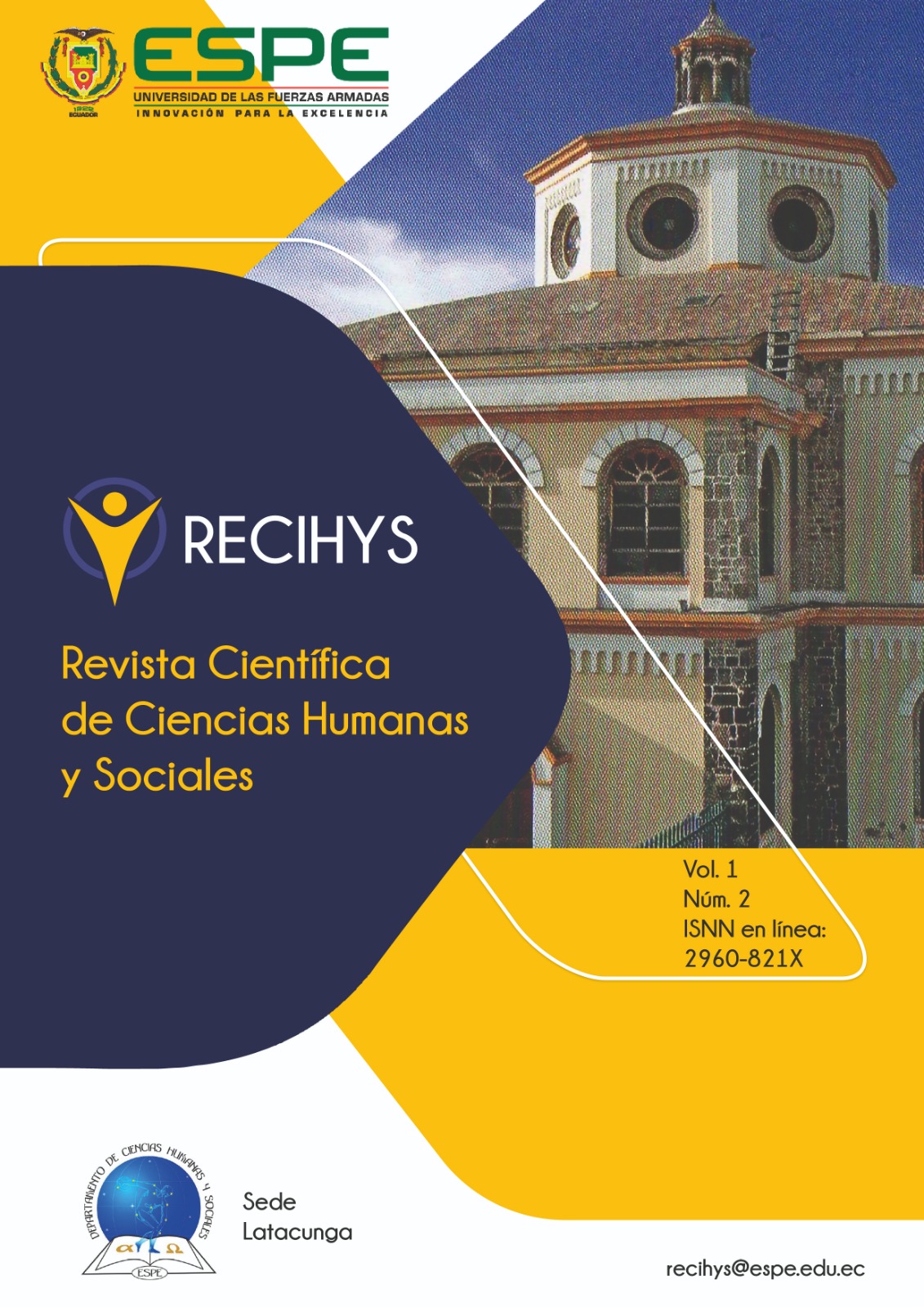Implementation of outdoor recreational activities to take advantage of the natural tourist resources of the parish of Lloa-Ecuador
Main Article Content
Abstract
Recreation is known as an activity destined to take advantage of free time, nowadays it is an essential factor for the tourism field, since recreation is related to tourism and has an important role in the quality of life of society, in such a way that the satisfaction of tourists depends on the different recreational activities for recreation that are carried out during the visit. This research was conducted with the purpose of determining the importance of the implementation of recreational activities for the strengthening of the natural tourism resources of the Lloa parish. The methodology was of qualitative approach, of bibliographic and documentary review, through essential sources such as books, articles, among others that have as a basis the implementation of recreational activities that can be executed in the content analysis. The results obtained were developed based on the review of several authors. Finally, it is pointed out that the implementation of recreational activities can be a significant contribution to improve the use of natural resources.
Downloads
Article Details

This work is licensed under a Creative Commons Attribution 4.0 International License.
Authors who publish in this journal agree to the following terms: Authors retain the copyright and guarantee the journal the right to be the first publication of the work, as well as, licensed under a Creative Commons Attribution License that allows others share the work with an acknowledgment of the authorship of the work and the initial publication in this journal. Authors may separately establish additional agreements for the non-exclusive distribution of the version of the work published in the journal (for example, placing it in an institutional repository or publishing it in a book), with acknowledgment of its initial publication in this journal. Authors are allowed and encouraged to disseminate their work electronically (for example, in institutional repositories or on their own website) before and during the submission process, as it may lead to productive exchanges as well as further citation earliest and oldest of published works.
How to Cite
References
Albán, G. P. G., Arguello, A. E. V., & Molina, N. E. C. (2020). Metodologías de investigación educativa (descriptivas, experimentales, participativas, y de investigación-acción). Recimundo, 4(3), 163-173.
Bernal, C. (2010). Metodología de la investigación (Tercera edición).
Bertoni, M. (2005). Recursos naturales en nodos turísticos. Aportes y Transferencias, 9(2), 95-111.
Cabezas, E. D., Andrade, D., & Torres, J. (2018). Introducción a la Metodología de la Investigación Científica. http://repositorio.espe.edu.ec/xmlui/bitstream/handle/21000/15424/Introduccion%20a%20la%20Metodologia%20de%20la%20investigacion%20cientifica.pdf?sequence=1&isAllowed=y
Camara, C. J., & Morcate, F. de los Á. (2014). Metodología para la identificación, clasificación y evaluación de los recursos territoriales turísticos del centro de ciudad de Fort-de-France. XXXV(1), 48-67.
Cañar Merelo, L. A. (2019). Diseño de un área de recreación turística en la cascada “El Imán”, provincia de los Ríos, año 2019. [Universidad Técnica Estatal de Quevedo]. https://repositorio.uteq.edu.ec/bitstream/43000/3923/1/T-UTEQ-0047.pdf
Carvajal, G. V., & Lemoine, F. A. (2018). Análisis de los atractivos y recursos turísticos del cantón San Vicente. 34, 164-184.
Castañer, M., & Camerino, O. C. (2001). La educación física en la enseñanza primaria: Una propuesta currículo para la reforma. INDE. https://books.google.com.br/books?id=qfKvHKCQzPQC&printsec=frontcover&hl=es#v=onepage&q&f=false
Collay, J. (2020). Actividades turístico recreativas para la dinamización del flujo de visitantes en las Pampas de Salasaca [Universidad Técnica de Ambato]. https://repositorio.uta.edu.ec/bitstream/123456789/31661/1/COLLAY%20SALAZAR%20DAYANA%20-ACTIVIDADES%20TURISTICO%20RECREATIVAS%20PARA%20LA%20DINAMIZACION%20DEL%20FLUJO%20DE%20VISITANTES%20EN%20LAS%20PAMPAS%20DE%20SALASACA_.pdf
Constitución de la República del Ecuador. (2008). https://www.acnur.org/fileadmin/Documentos/BDL/2008/6716.pdf
García, P. A., & Feria, M. F. (2022). Propuesta de actividades recreativas para el fortalecimiento del desarrollo turístico en el atractivo cerro y mirador El Calvario, cantón Zaruma. [Universidad Técnica de Machala]. http://repositorio.utmachala.edu.ec/bitstream/48000/19243/1/Trabajo_Titulacion_657.pdf
Gomes, C. J. G., & Turato, E. R. (2009). Análisis de contenido en investigaciones que utilizan la metodología clínico-cualitativa: Aplicación y perspectivas. Revista Latino-Americana de Enfermagem, 17(2), 259-264. https://doi.org/10.1590/S0104-11692009000200019
Gutiérrez, R., & Sánchez, J. (1990). Metodología del trabajo intelectual.10a ed. México: Esfinge. https://books.google.com.bo/books/about/Metodolog%C3%ADa_del_trabajo_intelectual.html?id=GK0QAAAAYAAJ&utm_source=gb-gplus-shareMetodolog
Grimaldi Puyana, M., Sánchez-Oliver, A. J., Alcaraz Rodríguez, V., & Pérez Villalba, M. (2017). Satisfacción laboral de trabajadores de actividades deportivas y recreativas en turismo activo. https://idus.us.es/handle/11441/85997
Larson, S., Farr, M., Stoeckl, N., Chacon, A., & Esparon, M. (2014). Does Participation in Outdoor Activities Determine Residents’ Appreciation of Nature: A Case Study From the Great Barrier Reef, Australia. Environment and Natural Resources Research, 4, 211-226. https://doi.org/10.5539/enrr.v4n3p212
Lozada, M. (2019). Recurso natural y los emprendimientos turísticos en el balneario de Agua Dulce la Reveza del cantón Palenque de la provincia de los Ríos [Universidad Técnica de Babahoyo]. http://dspace.utb.edu.ec/bitstream/handle/49000/6215/P-UTB-FCJSE-HTURIS-000075.pdf?sequence=1&isAllowed=y
Maya, E. (2014). Métodos y técnicas de investigación. Universidad Nacional Autónoma de México. http://www.librosoa.unam.mx/handle/123456789/2418
Merlotto, A., & Verón, E. M. (2019). Evaluación de los servicios culturales de recreación y turismo del ecosistema playa en la ciudad de Mar del Plata, Argentina. Revista Universitaria de Geografía, 28(2), 35-56.
Nasimba, C. y Cejas, M. (2015). Diseño de productos turísticos y sus facilidades. Ecuador. Revista Qualitas. Volumen 10. 22-39. https://www.researchgate.net/profile/Nasimba-Maribel/publication/333221285_Articulo_de_revision_DISENO_DE_PRODUCTOS_TURISTICOS_Y_SUS_FACILIDADES/links/5ce2cde7299bf14d95aa8667/Articulo-de-revision-DISENO-DE-PRODUCTOS-TURISTICOS-Y-SUS-FACILIDADES.pdf
Pérez Porto J, P. P., J. ,. Merino, M. (2015). Definición de actividades recreativas—Definicion.de. Definición de actividades recreativas - Qué es, Significado y Concepto. Definicion.de. https://definicion.de/actividades-recreativas/
Sánchez Flores, F. A. (2019). Fundamentos Epistémicos de la Investigación Cualitativa y Cuantitativa: Consensos y Disensos. Revista Digital de Investigación en Docencia Universitaria, 101-122. https://doi.org/10.19083/ridu.2019.644
Secretaría Nacional de Planificación. (2021). Plan de Creación de Oportunidades 2021-2025. https://observatorioplanificacion.cepal.org/sites/default/files/plan/files/Plan-de-Creaci%C3%B3n-de-Oportunidades-2021-2025-Aprobado_compressed.pdf
Sjögren, K., Hansson, E. E., & Stjernberg, L. (2011). Parenthood and factors that influence outdoor recreational physical activity from a gender perspective. BMC Public Health, 11(1), 93. https://doi.org/10.1186/1471-2458-11-93

